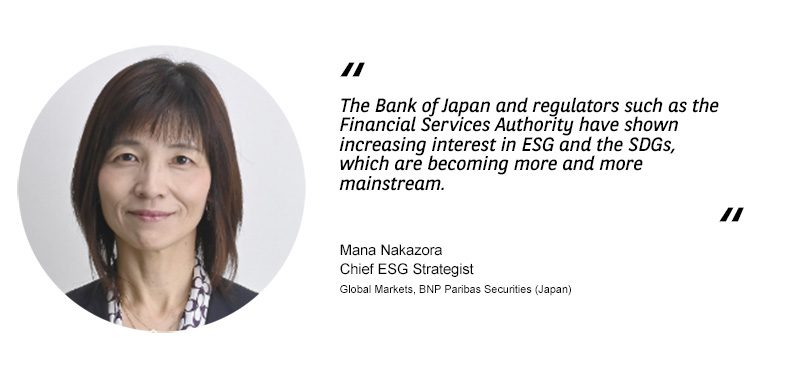This content is also available in:
Since its economic bubble burst in the early 1990s, Japan has been searching for a new and enduring growth strategy. When Yoshihide Suga succeeded Shinzo Abe as Prime Minister in September 2020, the government pledged that Japan will achieve net zero emissions by 2050 and stated its commitment to achieving a digital transformation across the economy and society. Working in concert, sustainability and digital could be the new catalysts for growth that the world’s third-largest economy has been seeking for so long.
In spite of its promise for Japan, though, decarbonisation will not be easy. The country’s existing electricity generation, transport and communications systems pre-date the climate change targets of the Paris Agreement and are likely to require replacement. Their large-scale, centralised or vertically integrated design and operations are too carbon-intensive for a net-zero future. Instead, the 2050 target will require building more distributed ‘smart grids’ and an historic investment in renewable energy.
These changes could help develop ‘smart cities’ and reinvigorate Japan’s regions, which have suffered from depopulation in a rapidly ageing society. But they will be extremely costly for a country that derives more than 91% of its primary energy from fossil fuels – and which has fallen behind in digital and sustainability alike.
Financial markets will be critical in mobilising the capital required for this far-reaching transition. That in turn will mean changing Japan’s saving culture, ingrained during decades of low growth and deflation, so that the country’s abundant financial resources can be put to work. Japanese companies have record amounts of cash – more than JPY200 trillion (US$1.9 trillion) – on their balance sheets. Household savings reached a 20-year high earlier this year.
Mana Nakazora, Chief ESG Strategist, Global Markets, BNP Paribas Securities (Japan), says Japanese corporates are already studying global developments like the Taskforce on Climate-related Financial Disclosure (TCFD) closely, aware that investors will more closely scrutinise their environmental, social and governance (ESG) performance in the future.

“Japanese companies are looking at the TCFD to understand the new rules around corporate disclosure. We’ve seen a clear and increasing trend of Japanese investors also prioritising TCFD in 2020,” says Mana.
With monetary policy remaining ineffective, Mr. Suga’s government will need to use fiscal stimulus to make firms and households alike feel secure in investing money amid the continuing Covid-19 pandemic.
Mana says the Japanese government is also expected to make more efforts to issue green bonds.
“So far we haven’t seen a green bond format for Japanese Government Bonds (JGBs) but the expectation for these is rising. The Bank of Japan and regulators such as the Financial Services Authority have shown increasing interest in ESG and the Sustainable Development Goals, which are becoming more and more mainstream,” she says.
Distributed power
This stimulus should have lasting benefits – and the transition to autonomous and decentralised renewable energy systems is an excellent candidate for government spending. Japan now aims to be the world’s third largest offshore wind power producer, with 49 gigawatts by 2040, and intends to stay ahead in Asia’s march to a net zero future.Advances in big data and blockchain allow for the creation of distributed networks of generators powered by renewable energy, and for surplus energy to be traded in a fair and efficient way. Internet of Things (IoT) and 5G technology are accelerating these systems’ viability as replacements for existing ‘top-down’ systems built around power stations.
This investment should also make Japan more resilient. Located on the Pacific ‘ring of fire,’ which experiences frequent seismic activity, the country has a particular vulnerability to earthquakes and tsunamis. This was made clear by the 2011 Tōhoku earthquake and tsunami, which damaged the Fukushima nuclear power plant and made further nuclear development politically unfeasible.
Instead, to prevent black-outs and their impacts on productivity and quality of life, the country has invested in defensive energy infrastructure that is strongly centralised and has ‘top-down’ structure: a power utility owns all elements of the generation and distribution process.
But just as the internet was developed to maintain a resilient communications network in the event of war and has rapidly decentralised commercial communications, the decentralisation of power networks into smart grids would make for a more robust, flexible and resilient system.
These intelligent, self-sufficient networks could help develop more distributed, more autonomous smart cities. And these should be more resilient to Japan’s natural disasters, less carbon-intensive, and attractive to investors during their construction and operational phases. Building these cities could kick-start a sustained revival for Japan’s economy.
What happens next?
Economic growth does not have to depend on burning more carbon, as Sweden showed between 1990 and 2017, when it cut CO2 emissions by 28% while expanding its economy by 77%. And, despite the challenges it faces, Japan’s pathway to net zero may provide a useful point of reference to Australia, another developed Asia Pacific economy – but one that has yet to commit to carbon neutrality.For both Japan and Australia, pandemic-driven fiscal stimulus provides an opportunity to make decisions about the energy strategy and economy of the future. Australia has opted to double down on natural gas as the basis of its future power network; Japan has made a commitment to carbon neutrality and must now invest heavily to capture the potential of smart grids and renewables. If it can combine this energy transition with a digital transformation, it could be the basis for a new and enduring growth strategy.